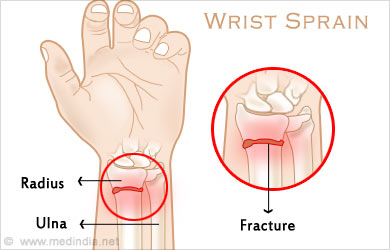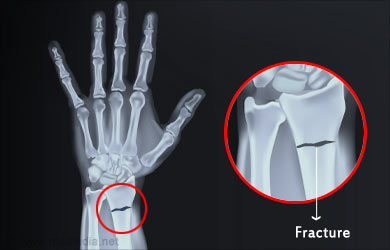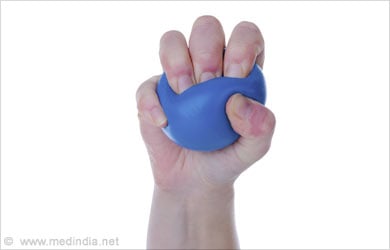- Wrist Sprains - (http://orthoinfo.aaos.org/topic.cfm?topic=a00023)
- Wrist sprain - Aftercare - (http://www.nlm.nih.gov/medlineplus/ency/patientinstructions/000568.htm)
About
A wrist sprain is an injury to a ligament in the wrist. It may be mild, moderate or severe, depending on the extent of injury.
A wrist sprain is an injury to a ligament in the wrist. Ligaments are bands of connective tissue that act as links between bones. Wrist sprains may be mild, moderate or severe depending on the extent of injury to the ligaments.

Wrist sprains may be graded as follows -
- Grade 1. When the sprain is mild and when the ligament is merely stretched but not torn.
- Grade 2. When the sprain is moderate and the ligament is partially torn. These wrist injuries may involve a loss of function.
- Grade 3. When the sprain is severe and the ligament is completely torn and requires medical or surgical care. When this injury occurs, the ligament may tear away completely and take a small piece of bone along with it, leading to an avulsion fracture.
Wrist sprains usually occur from falls, especially during sporting or recreational activities and hence it can be prevented by exercising care while moving on slippery surfaces. While engaging in sports or recreational activities, it is advisable to wear protective gears such as wrist guards, splints or protective tape to avoid injuries to the wrist.
Wrist sprain Causes
A wrist sprain can occur to anyone who experiences a fall on an outstretched hand; nevertheless, it occurs more commonly in those engaged in sporting activities.
A wrist sprain is a common injury, especially in athletes such as
However, these sprains can occur to anyone during their everyday activities too.
All it takes to acquire a wrist sprain is to lose your balance momentarily. It is natural to stretch your hand to regain balance, but if you fall on your outstretched hand, a sprain occurs. Wrist sprains can also occur if you are hit on the wrist or if your wrist is bent or twisted. There are several ligaments in the wrist area that may be stretched or torn, leading to a sprain.
Wrist Sprains Symptoms
Common symptoms of wrist sprain includes pain and swelling in the wrist.
Some of the most common symptoms of wrist sprain include -
- Wrist Pain

- Swelling in the wrists
- Persistent pain on moving wrists
- Bruising and discoloration
- Tenderness in the injured wrists
- Warm feeling at the site of injury
- A popping / tearing feeling inside wrist
Wrist sprain symptoms may vary in intensity and location. Sometimes, a wrist injury may appear mild but there could be a significant ligament tear that might require surgery. In some cases, an unrecognized (occult) fracture may be mistaken for a sprained wrist and may not get the appropriate medical attention necessary for fractures.
If left untreated, a broken bone may not heal and could lead to grave complications. A classical example is the scaphoid bone fracture. Therefore, it is important that all wrist injuries are medically assessed and treated properly to avoid long-lasting complications.
Wrist Sprain Diagnosis
Wrist sprain diagnosis is carried out by examining symptoms and analyzing the medical history of the patient. This may be aided with imaging tests of the site of injury.
Your doctor will examine your symptoms and ask you questions relating to your injury. He/she will examine if there are other related injuries, check for tenderness on the injured wrist, and will also review your medical history to find out if you have had previous injuries to the wrist. Moderate injuries, like a partial ligament tear, may be difficult to diagnose but if they are not properly treated, are likely to cause chronic physical abnormalities.
Your doctor is likely to order imaging tests such as X-rays to help diagnose wrist sprain. In some cases magnetic resonance imaging (MRI) scan, computed tomography (CT) scan, or arthrogram may be ordered.

X-rays are not capable of revealing ligament injuries but can help diagnose bone -related injuries. MRI and CT scan can reveal finer injuries that are not seen in X-rays. An arthrogram is another diagnostic test taken to diagnose wrist sprains. It involves injecting a dye into the joint of the wrist to enable the joint and ligaments to show up more clearly.
Wrist sprain - Treatment
Wrist sprains must be given first aid through the RICE method. Depending on the nature of injury, the hand may be immobilized with splints or surgically treated.
Mild wrist sprains may be subjected to home treatment using the RICE protocol (explained in the next section).
A pain medication, such as aspirin or ibuprofen, may be administered. If pain and swelling persist for more than 48 hours after injury, consult a doctor.
Nonsurgical Treatment
Those with moderate sprains must wear wrist splints for a week or more to immobilize the injured wrist. This may cause some discomfort and stiffness in the wrist area for which the doctor may recommend few stretching exercises to overcome the problems.
Surgical Treatment
If the sprain is severe it may require surgery at the earliest, to repair the fully torn ligament and reconnect it to the bone. Your doctor will discuss the surgical options that may best suit your injury. Surgery is followed by rest and exercises to gain strength and restore movement. Healing takes about two months, although full recovery will take a few more months.

Here are a few strength- building exercises –
Keep your palm facing up. Keep a rubber ball in the center of your palm and grab it with your fingers

- Do not shake your hand and wrist. Now gently squeeze the ball for 30 seconds and then release
- Repeat this 20 times, twice a day
Exercises to increase flexibility and movement-
- Warm wrist by using a heating pad for about 10 minutes.
- Hold out your injured hand and grab your fingers using the un-injured hand. Slowly bend the fingers and the wrist backwards just until you begin to feel discomfort. Hold for 30 sec until it begins to feel uncomfortable. Bring back to original position.
- After a minute of relaxation repeat this stretching exercise five times.
- Repeat exercise in the opposite direction.
- Do both these exercises twice a day. In case of discomfort apply ice for 20 min after exercise
Follow ups are absolutely vital to monitor progress of the injury.







